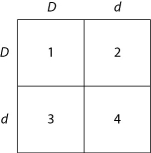Use Figure 14.1 and the following description to answer the questions below.
In a particular plant, leaf color is controlled by gene locus D. Plants with at least one allele D have dark green leaves, and plants with the homozygous recessive dd genotype have light green leaves. A true-breeding dark-leaved plant is crossed with a light-leaved one, and the F₁ offspring is allowed to self-pollinate. The predicted outcome of the F₂ is diagrammed in the Punnett square shown in Figure 14.1, where 1, 2, 3, and 4 represent the genotypes corresponding to each box within the square.

Figure 14.1
-Which of the plants will be true-breeding?
Definitions:
States of Nature
Hypothetical conditions or scenarios in decision theory and economics, representing all possible situations that could affect the outcome of a decision.
EMV
An acronym for Expected Monetary Value, a calculation used in decision making that quantifies the average outcome of a future event in monetary terms.
Payoff Table
A tool used in decision making that shows the outcome or results of different strategies under various conditions.
Expected Value Criterion
A decision-making approach that aims to maximize the expected outcome by taking into account all possible variations in performance.
Q2: Which viruses have single-stranded RNA that acts
Q10: A particular cell has half as much
Q20: What explains anchorage dependence of animal cells
Q21: What is the purpose of beta oxidation
Q22: Which of the following is the best
Q22: Which of the following types of RNA
Q32: What is the correct chromosomal condition at
Q37: You have the technology necessary to measure
Q64: If true-breeding red long radishes are crossed
Q72: Which of the following would be inhibited